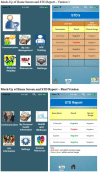A user-centered model for designing consumer mobile health (mHealth) applications (apps)
- PMID: 26903153
- PMCID: PMC4837063
- DOI: 10.1016/j.jbi.2016.02.002
A user-centered model for designing consumer mobile health (mHealth) applications (apps)
Abstract
Background: Mobile technologies are a useful platform for the delivery of health behavior interventions. Yet little work has been done to create a rigorous and standardized process for the design of mobile health (mHealth) apps. This project sought to explore the use of the Information Systems Research (ISR) framework as guide for the design of mHealth apps.
Methods: Our work was guided by the ISR framework which is comprised of 3 cycles: Relevance, Rigor and Design. In the Relevance cycle, we conducted 5 focus groups with 33 targeted end-users. In the Rigor cycle, we performed a review to identify technology-based interventions for meeting the health prevention needs of our target population. In the Design Cycle, we employed usability evaluation methods to iteratively develop and refine mock-ups for a mHealth app.
Results: Through an iterative process, we identified barriers and facilitators to the use of mHealth technology for HIV prevention for high-risk MSM, developed 'use cases' and identified relevant functional content and features for inclusion in a design document to guide future app development. Findings from our work support the use of the ISR framework as a guide for designing future mHealth apps.
Discussion: Results from this work provide detailed descriptions of the user-centered design and system development and have heuristic value for those venturing into the area of technology-based intervention work. Findings from this study support the use of the ISR framework as a guide for future mHealth app development.
Conclusion: Use of the ISR framework is a potentially useful approach for the design of a mobile app that incorporates end-users' design preferences.
Keywords: Design science; HIV; MSM; Mobile apps; User-centered; mHealth.
Copyright © 2016 Elsevier Inc. All rights reserved.
Figures
References
-
- Kumar S, Nilsen WJ, Abernethy A, et al. Mobile Health Technology Evaluation: The mHealth Evidence Workshop. Am J Prev Med. 2013;45(2):228–36. doi: http://dx.doi.org/10.1016/j.amepre.2013.03.017. - DOI - PMC - PubMed
-
- IMS Institute for Healthcare Informatics Patient Apps for Improved Healthcare: From Novelty to Mainstream. 2013
Publication types
MeSH terms
Grants and funding
LinkOut - more resources
Full Text Sources
Other Literature Sources
Medical





